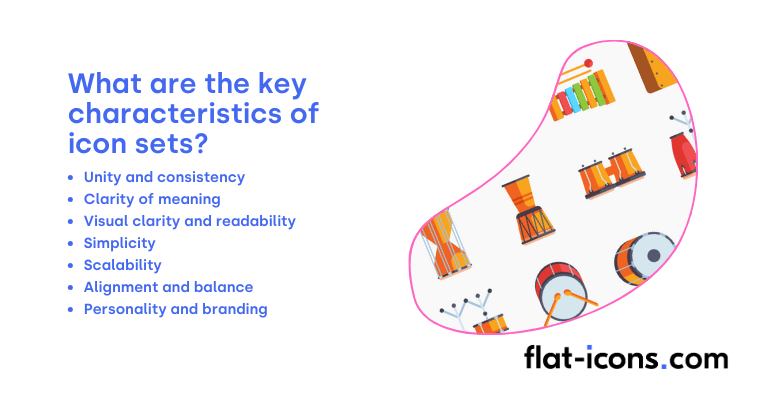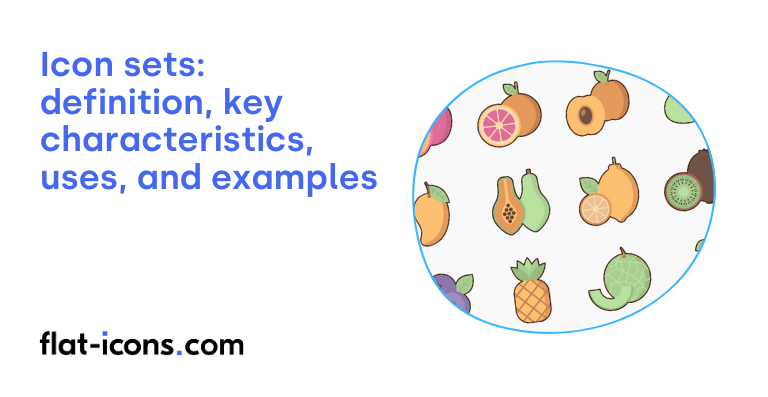Icon sets are collections of digital icons that share a consistent visual style and are designed to be used together for a unified look and feel across a project or interface.
The key characteristics of icon sets are unity and consistency, clarity of meaning, visual clarity and readability, simplicity, scalability, alignment and balance, and personality and branding.
Icon sets are typically used in user interface (UI) design, web design, mobile apps, print materials, data visualization, and presentations.
Table of Contents
What are icon sets?
Icon sets are collections of icons specifically designed to function harmoniously, with visual unity being the primary consideration across all the individual elements. The icons within such sets display a consistent visual style, ensuring they are perceived as cohesive collections rather than random mixes of graphics, representing an additional icon category defined by their unified design. This visual coherence is generally accomplished through the application of uniform design attributes, such as consistent line weight across all icons, matching styles for edges and corners, and a shared color palette if color is part of the design.
What are the key characteristics of icon sets?

The key characteristics of icon sets are listed below.
- Unity and consistency: All icons within the set share a consistent visual style, ensuring they look like they belong together.
- Clarity of meaning: Each icon in the set unambiguously conveys its intended message or function to the user.
- Visual clarity and readability: Icons are designed to be legible and instantly recognizable, even when displayed at small sizes within the user interface.
- Simplicity: Effective icon sets prioritize simplicity, including only the necessary details for recognition and avoiding unnecessary clutter or complexity.
- Scalability: Icons within the set are designed to be used in various sizes across different devices and screen resolutions without losing clarity or quality.
- Alignment and balance: The elements within each icon are positioned in a way that appears visually correct, harmonious, and well-balanced.
- Personality and branding: The overall style and design of the icon set should reflect the visual identity, personality, and branding of the product or brand it represents.
Where are icon sets typically used?

Icon sets are typically used as listed below.
- User interface (UI) design: Integral components of websites, web applications, mobile applications, and desktop software, ensuring a consistent visual language across the digital product.
- Web design: Enhance visual appeal and significantly improve user navigation by providing recognizable visual cues for different sections and actions.
- Mobile apps: Crucial for providing intuitive navigation and representing functionality in a compact manner, optimizing the user experience on smaller screens.
- Print materials: Extend their consistent visual language to tangible items like brochures, business cards, and posters, maintaining brand identity across mediums.
- Data visualization: Represent data points or categories in a visually accessible and engaging way, making complex information easier to understand.
- Presentations: Serve as valuable visual aids, helping to communicate information more effectively and engagingly by illustrating key points and concepts.
When should you use icon sets?
You should use icon sets strategically within a design project when you want to enhance visual communication. Icons can often convey meaning more rapidly and effectively than lengthy text descriptions, making them a valuable tool for improving user understanding at a glance.
Another primary reason to incorporate icon sets is to improve navigation and overall usability within your interface. By providing immediate visual cues for different actions and functions, icons make it easier for users to understand and interact with the application or website.
Finally, icon sets are particularly useful in environments with limited screen real estate, such as mobile interfaces. They allow you to save valuable space while still providing users with clear access to various features and functionalities.
What are the pros and cons of using icon sets?
The pros of using icon sets are listed below.
- Improve visual communication and user experience: Icon sets can improve information comprehension, make interfaces more engaging, and provide intuitive navigation.
- Promote efficiency and scalability: They optimize screen space, contribute to faster loading speeds (with certain formats), and offer scalability without quality loss.
- Ensure design consistency and branding opportunities: Using a unified set creates a consistent visual language and allows for icons to be tailored to a brand’s identity.
- Potential for universal understanding: Commonly used icons can transcend language and cultural barriers.
The cons of using icon sets are listed below.
- Potential for ambiguity and misinterpretation: The meaning of icons is not always universally clear and can lead to user confusion.
- Accessibility challenges: Without proper implementation, such as providing alternative text, icon sets can create barriers for visually impaired users.
- Risk of visual clutter and inconsistency: Overuse of icons can lead to a cluttered interface, and inconsistent styles across a set can create a disjointed user experience.
- Difficulty representing complex concepts and learning curve: Simple icons may struggle to convey intricate ideas, and unique or unconventional icons can require users to learn their meaning.
- Limitations of certain formats and conflicting meanings: Icon fonts may have limitations in detail and color, and some common icons can have different meanings across platforms.
Read more icon articles
